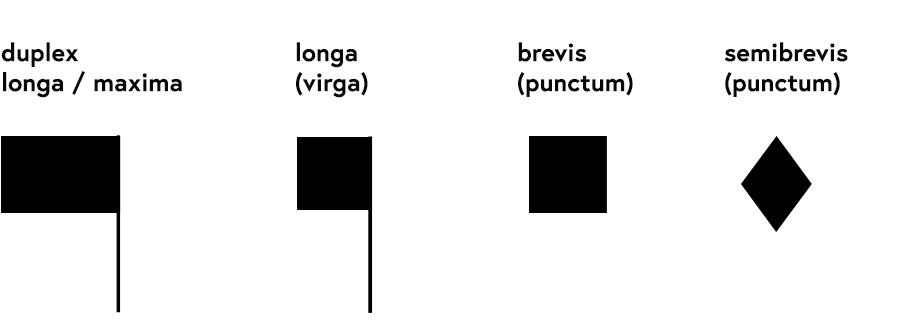EARLY MENSURAL NOTATION
4.2
The notational system of mensural music
The basic idea of mensural music is that rhythm can be represented by the shape of the notes. Mensural notation establishes a new notational system that enables the encoding of exact rhythmic values in the figures of the notes.
During the second half of the 13th century musical composition evolved in a way that facilitated the development of a new method of measuring musical time. As we learned, modal notation could not provide a system that was differentiated enough to notate elaborate rhythm. Therefore, a new way of visualising note values emerged. The duration of a note was no longer represented through the concept of numbers, but instead it was inscribed in the shape of the signs. A fundamental shift took place from rhythm as numerus to rhythm as figura.
Two music theorists summed up this historical development in their treatises: Magister Lambertus in his Tractatus de Musica (1270) and Franco of Cologne in his Ars Cantus Mensurabilis (1280). This newly introduced notation method put the emphasis on the concept of the figura. The shape, the figure of the notes was no longer just an extrinsic feature of writing; it became an essential and highly significant aspect of musical notation.
Let us now have a look at the notational signs of early mensural notation. The signs, both single and ligated notes, became loaded with a new semiotic charge - their duration was now recognisable from the shape of the square notes:

The older names of virga and punctum were replaced by longa, brevis and semi-brevis, the latter taking the form of a small rhombus. A sign, which had already been in use in modal notation and which had indicated a longer note, was also introduced under the name of duplex longa or maxima. The relation between maxima and longa can be binary or ternary:

The relation between longa, brevis and semi-brevis is always ternary (perfect):

The strokes called plica are still in use in mensural notation. They are applied to longae and breves, establishing a visual differentiation in a systematic way: in musical manuscripts from the 13th century you find a sign for the longa with plica and a sign for the brevis with plica. The difference is marked by the length and the position of the stroke:


As you can see, a longer stroke is applied to the left side of the breves in addition to the (shorter) plica stroke, to make sure you don’t confuse it with a longa.
Mensural notation is a well-organised notational system based on the knowledge of a complex system of rules. In the following steps you will explore these rules and learn, how to handle some tricky cases of ambiguous notation. Thus you will find out how to read and transcribe mensural music from the 13th century.
References
Lambertus (Quidam Aristoteles). Tractatus de musica, E. de Coussemaker, Scriptorum de musica medii aevi, vol. 1: Hildesheim, 1963, p. 251–281.
Franco de Colonia. Ars cantus mensurabilis. G. Reaney/A. Gilles: CSM 18, Rome 1974.
Manuscripts
Montpellier, Faculté de Médecine, H 196, (ca. 1270).
Bamberg, Staatsbibliothek, Lit. 115, Ed. IV.6, (ca. 1290).
Las Huelgas, Monasterio de Santa Maria la Real, without shelfmark (ca. 1300–1325).
License
Copyright: University of Basel
